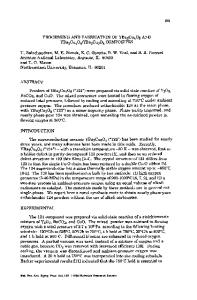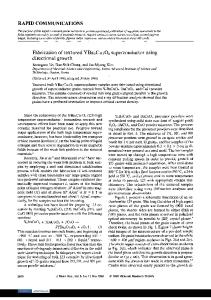Growth rate estimation of YBa 2 Cu 3 O x single crystal grown by crystal pulling
- PDF / 580,921 Bytes
- 4 Pages / 576 x 792 pts Page_size
- 2 Downloads / 314 Views
We have estimated the growth rate of the YBa2Cu3Ox crystal grown from the solution by crystal pulling, in terms of solute diffusion in the liquid with convection. The maximum growth rate deduced from the solute diffusion rate is roughly estimated to be about one order larger than the typical measured value. This implies that the driving force for the surface reaction is significantly larger when compared to the total driving force for the growth of YBa 2 Cu 3 0 x crystal in our method.
I. INTRODUCTION Preparation of the single crystal of high-r c oxides has been performed by many procedures. The aim of growing the single crystals is not only for physical property measurements but also for developing superconducting devices which have some new functions. One of the major processes for forming the single crystals is thin film processing. This is not, however, advanced enough to obtain the single crystals on substrates. Therefore, we have studied the processing of the single crystal from a liquid and succeeded in continuous growth of a bulky YBa 2 Cu 3 0 x (Y123) single crystal. Although the single crystal of Y123 with a dimension of about 100 mm3 has been obtained by using the solution growth method,1 it would be very difficult to grow the crystal large enough for devices. To obtain larger crystals, we have successfully developed a continuous growth method by the pulling technique, and named it the Solute Rich Liquid Crystal Pulling (SRLCP) method.2 However, in order to control the crystal growth and to optimize the growth conditions, we have to understand the growth mechanism. Single crystals of the Y123 grown from B a - C u - 0 solution by the SRL-CP method have facet faces of {100}, {001}, and {101}.2-3 The occurrence of the faceted faces means that not only the solute diffusion process but also the crystallization process on the faces play an important role for growth. However, this does not imply that the growth is limited by the surface reaction process. A comparison between the contributions of the surface reaction process and the solute diffusion process is needed. In order to understand the macroscopic growth mechanism of the Y123, it is important to know which process determines the growth rate. In this paper we have estimated the growth rate, followed by the analysis which is based upon the Cochran flow near the growing crystal. We have compared the experimental rate with the rate estimated by a model, J. Mater. Res., Vol. 10, No. 7, Jul 1995 http://journals.cambridge.org
Downloaded: 14 Mar 2015
taking into account the diffusion of the solute in the solution with forced convection due to the rotation of the crystal.
II. GROWTH PROCEDURE AND RESULTS The green powder of the Y211 phase of the solute was first placed on the bottom of the crucible. Then the solvent, 3BaCuO2 • 2CuO, was put on the solute. After melting completely, the depth of the solution was about 25 mm and the thickness of the layer of the Y211 phase on the bottom of the crucible was about 10 mm. The configuration of the solution during t
Data Loading...











